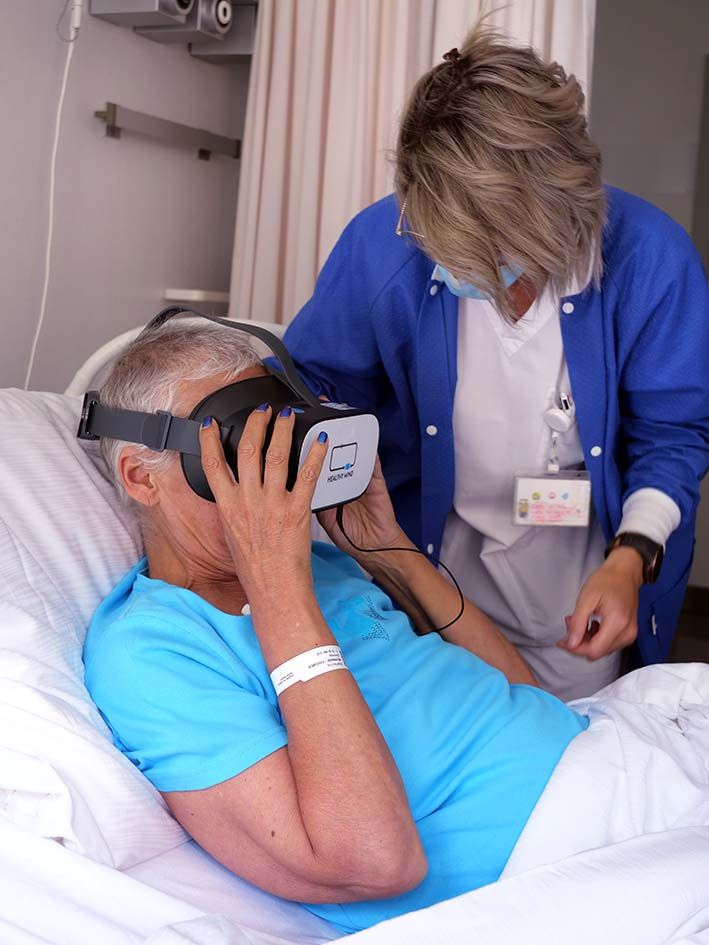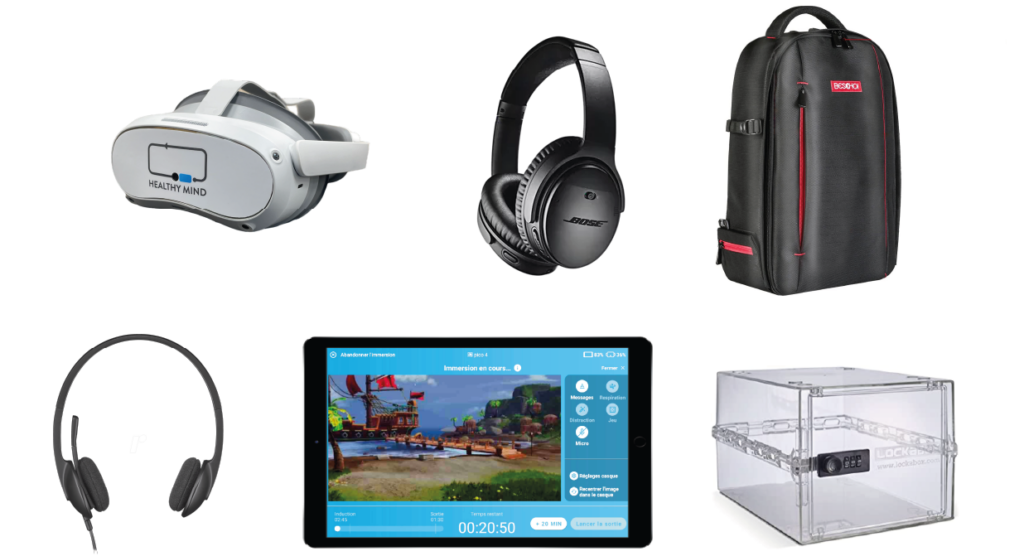
During a recovery period Aftercare and rehabilitation care (FRC) becomes the link between home and hospital. Dedicated in this medical environment rehabilitation, Virtual Reality (VR) offers an innovative path forward. In the search for recovery, this immersive technology offers the opportunity improve the quality of life of hospital patients through therapeutic instruments with proven effectiveness. How do helmets fit in? FRC facilities, and what new features do they offer? That’s what we’ll find out in this article.
Aftercare and Rehabilitation Care (FRC): What is at stake?
After an injury, illness or operation, patients benefit from aftercare and rehabilitation care. Hospitalization in FRC is accessible by prescription and is divided into three areas:
- Re-educationto help patients restore their physical, cognitive and psychological abilities;
- rehabilitation adapting to limitations and learning to overcome them;
- Reintegrationwith the aim of regaining true independence.
Hospitalization in the FRCwhether in whole or in part, is a multidisciplinary process. Several medical professionals share their expertise to create an environment that favors remission, both in terms of care and family, social, school or professional reintegration. This is how the FRC helps create a therapy plan It is adapted to the patient’s health status and facilitates referrals to health and social services.
Aftercare and rehabilitation is an essential part of the healthcare system and plays a crucial role in patients’ transition from hospital to everyday life. FRC facilities are used to ensure this Continuity of medical and paramedical careHelp patients with this recovering after a hospital stay.

The effectiveness of virtual reality remediation: a scientific perspective
Aftercare and rehabilitation care covers a wide range of medical conditions:
- musculoskeletal system;
- nervous system;
- digestive, metabolic and endocrine systems;
- cardiovascular, respiratory and oncohematological pathologies;
- burn patients;
- Addictionology.
Some facilities specialize in obesity, psychiatric disorders, cardiovascular disease, and care for the elderly or young children. So how do we respond to this? wide range of treatments and patients involved?

Therapeutic virtual reality offers a Multi-purpose device that addresses the problems multiple use cases and can be adapted to all target groups. Instead of being limited to the specific needs of a disease, this tool is used improve comfort and well-being of all patients. In addition, the variety of immersions and the creativity of the environments arouse curiosity and Acceptance at any age.
Numerous clinical studies have shown that it not only stimulates the imagination and promotes calm and relaxation Effectiveness of virtual reality remediation for a variety of conditions treated in FRC facilities:
To learn more, you can read about others clinical studies to which Healthy Mind has contributed on our special page.
Healthy Mind headsets: More comfort for patients and nursing staff
1. Reduced anxiety and pain without medication
Staying in an FRC is often accompanied by a high level of anxiety. Between the complexity of treatment, concerns about remission or current health status, and the difficult transition between hospital and home, patients face many upheavals.
Virtual reality offers one captivating and calming escape for patients and takes them into relaxing virtual landscapes such as sunny beaches or snow-capped mountains. The distracting sensory immersion helps reduce stress and anxiety and creates an environment more conducive to healing.
Virtual reality has proven to be effective Pain management without the use of medication. The visual and auditory distractions of virtual reality draw patients’ attention away from their own bodies physical pain, a technique that has proven to be effective. Virtual walks immerse users relaxing atmosphere to escape the reality of an anxiety-inducing and sometimes oppressive medical environment, a space outside of time.
The non-pharmacological approach represents a significant advance in comfort management for patients with FRC who may suffer from postoperative or postoperative problems chronic pain.
The introduction of virtual reality in FRC is not limited to improving physical rehabilitation, but also brings real benefits in terms of psychological well-being, reducing anxiety and pain in a non-pharmacological way, thus promoting better well-being holistic healing process.
2. A versatile tool for a variety of uses
Therapeutic virtual reality is not limited to a 3D headset. The Healthy Mind device uses multiple processes to deliver a multisensory experience:
- medical hypnosis developed by professionals;
- breathing exercises for postoperative rehabilitation;
- a calming background noise;
- interactive games without joysticks to increase distraction;
- Immersions without cyberkinetosis.
tea Virtual reality headset can be perfectly integrated into FRC facilities to relieve pain and anxiety from:
- organ or muscle reeducation;
- rehabilitation after surgery;
- pressotherapy sessions;
- massages;
- joint mobilization;
- electrophysiotherapy;
- changing dressings;
- infusions;
- occupational therapy for neurofunctional problems;
- paraplegia;
- chronic pain;
- Eating disorder.
The versatility of virtual reality in FRC opens up a number of options for tailoring patient care to their individual needs. This not only helps improve medical outcomes, but also makes the rehabilitation experience more engaging and motivating for patients and increases their adherence to treatment.
3. A mobile, compact system that integrates into the care process

Numerous people are involved in aftercare and rehabilitation. Due to the diversity of caregivers and use cases, introducing a cumbersome tool would slow down medical management smooth process of care.
To meet this need, Healthy Mind offers:
- a 4K wireless headset that can be quickly deployed off-network;
- a compact storage bag;
- a medical application for parameter setting, monitoring and control of immersion;
- Support to help you familiarize yourself with the equipment.
No internet connection is required to connect the headset and tablet. This allows you to integrate the interface into the medical workflow without relying on external parameters – the device is self-sufficient. The device allows the patient and nursing staff to move freely while ensuring the possibility of constant communication.
Virtual reality is much more than just one technological innovation for FRC, it represents an opportunity to optimize the care journey for patients and healthcare professionals. It provides a powerful means of Improving patient comfort by reducing anxiety and pain while being adaptable and easy to integrate into facilities. The associated benefits in terms of physical rehabilitation, psychological well-being and effective care pave the way for this faster recovery. Would you like to see the device in action? Don’t hesitate Ask for a demonstration!





